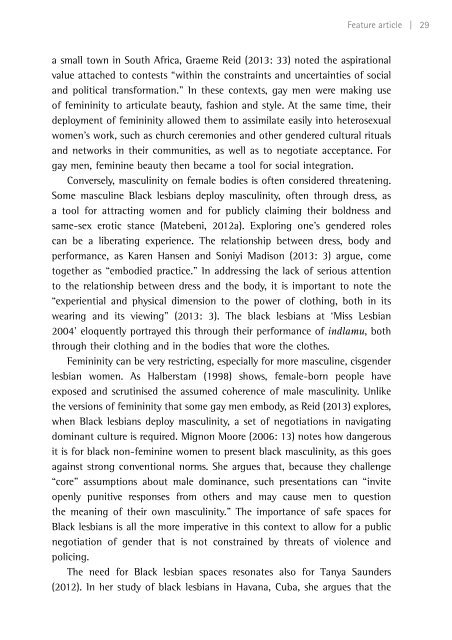The politics of fashion and beauty in Africa
fa21_proof_3
fa21_proof_3
You also want an ePaper? Increase the reach of your titles
YUMPU automatically turns print PDFs into web optimized ePapers that Google loves.
Feature article | 29<br />
a small town <strong>in</strong> South <strong>Africa</strong>, Graeme Reid (2013: 33) noted the aspirational<br />
value attached to contests “with<strong>in</strong> the constra<strong>in</strong>ts <strong>and</strong> uncerta<strong>in</strong>ties <strong>of</strong> social<br />
<strong>and</strong> political transformation.” In these contexts, gay men were mak<strong>in</strong>g use<br />
<strong>of</strong> fem<strong>in</strong><strong>in</strong>ity to articulate <strong>beauty</strong>, <strong>fashion</strong> <strong>and</strong> style. At the same time, their<br />
deployment <strong>of</strong> fem<strong>in</strong><strong>in</strong>ity allowed them to assimilate easily <strong>in</strong>to heterosexual<br />
women’s work, such as church ceremonies <strong>and</strong> other gendered cultural rituals<br />
<strong>and</strong> networks <strong>in</strong> their communities, as well as to negotiate acceptance. For<br />
gay men, fem<strong>in</strong><strong>in</strong>e <strong>beauty</strong> then became a tool for social <strong>in</strong>tegration.<br />
Conversely, mascul<strong>in</strong>ity on female bodies is <strong>of</strong>ten considered threaten<strong>in</strong>g.<br />
Some mascul<strong>in</strong>e Black lesbians deploy mascul<strong>in</strong>ity, <strong>of</strong>ten through dress, as<br />
a tool for attract<strong>in</strong>g women <strong>and</strong> for publicly claim<strong>in</strong>g their boldness <strong>and</strong><br />
same-sex erotic stance (Matebeni, 2012a). Explor<strong>in</strong>g one’s gendered roles<br />
can be a liberat<strong>in</strong>g experience. <strong>The</strong> relationship between dress, body <strong>and</strong><br />
performance, as Karen Hansen <strong>and</strong> Soniyi Madison (2013: 3) argue, come<br />
together as “embodied practice.” In address<strong>in</strong>g the lack <strong>of</strong> serious attention<br />
to the relationship between dress <strong>and</strong> the body, it is important to note the<br />
“experiential <strong>and</strong> physical dimension to the power <strong>of</strong> cloth<strong>in</strong>g, both <strong>in</strong> its<br />
wear<strong>in</strong>g <strong>and</strong> its view<strong>in</strong>g” (2013: 3). <strong>The</strong> black lesbians at ‘Miss Lesbian<br />
2004’ eloquently portrayed this through their performance <strong>of</strong> <strong>in</strong>dlamu, both<br />
through their cloth<strong>in</strong>g <strong>and</strong> <strong>in</strong> the bodies that wore the clothes.<br />
Fem<strong>in</strong><strong>in</strong>ity can be very restrict<strong>in</strong>g, especially for more mascul<strong>in</strong>e, cisgender<br />
lesbian women. As Halberstam (1998) shows, female-born people have<br />
exposed <strong>and</strong> scrut<strong>in</strong>ised the assumed coherence <strong>of</strong> male mascul<strong>in</strong>ity. Unlike<br />
the versions <strong>of</strong> fem<strong>in</strong><strong>in</strong>ity that some gay men embody, as Reid (2013) explores,<br />
when Black lesbians deploy mascul<strong>in</strong>ity, a set <strong>of</strong> negotiations <strong>in</strong> navigat<strong>in</strong>g<br />
dom<strong>in</strong>ant culture is required. Mignon Moore (2006: 13) notes how dangerous<br />
it is for black non-fem<strong>in</strong><strong>in</strong>e women to present black mascul<strong>in</strong>ity, as this goes<br />
aga<strong>in</strong>st strong conventional norms. She argues that, because they challenge<br />
“core” assumptions about male dom<strong>in</strong>ance, such presentations can “<strong>in</strong>vite<br />
openly punitive responses from others <strong>and</strong> may cause men to question<br />
the mean<strong>in</strong>g <strong>of</strong> their own mascul<strong>in</strong>ity.” <strong>The</strong> importance <strong>of</strong> safe spaces for<br />
Black lesbians is all the more imperative <strong>in</strong> this context to allow for a public<br />
negotiation <strong>of</strong> gender that is not constra<strong>in</strong>ed by threats <strong>of</strong> violence <strong>and</strong><br />
polic<strong>in</strong>g.<br />
<strong>The</strong> need for Black lesbian spaces resonates also for Tanya Saunders<br />
(2012). In her study <strong>of</strong> black lesbians <strong>in</strong> Havana, Cuba, she argues that the



